Gaia must have been fond of dinosaurs, since she created so many of them and let them live on Earth for such a long time. But dinosaurs were living in a world that was very different from what it is now.
I don’t know what strategy you use to sleep soundly and well. For me, it consists of ruminating scientific questions. It works beautifully to take me to the realm of dreams, but it also leads me to unexpected lines of thought. Especially having a smartphone nearby, I may wake up in the middle of the night, fire up an AI, and ask weird questions. A few nights ago, my wife woke up, asking me, “What the heck are you looking at on your phone at 2 a.m. in the night?” And I showed her my query for “Role of methanotrophs in the digestion of cellulosic material in dinosaurs.” Fortunately, she knows me well.
Anyway, the question I have been thinking about during the past few weeks is about the Mesozoic climate. In a recent paper, Emily Judd and her co-authors defined their results as the “Mesozoic Conundrum.” For you to figure out what is meant for “Mesozoic” here is a table of the ages of Earth, as they are named today. The Mesozoic is known as the “era of dinosaurs” and it is the era that preceded the current one, the Cenozoic, in which we are living today.
And here are Judd’s results.
You can see that something doesn’t click as it is expected to. The Mesozoic, the age of dinosaurs, spanned some 180 million years, from 255 to 65 My ago and, during this period, the CO2 concentration remained in the range of 700-1000 ppmv, much higher than the current one of 420 ppmv. As expected, temperatures were high, but they also changed, increasing by some 10 °C and even more during the period (look at the yellow dots in the “B” image; GMST stands for “Global Mean Surface Temperature). On the contrary, the correlation is good for the Cenozoic (our era) and not bad for the Paleozoic, it is not good for the Mesozoic. Hence, the “Mesozoic conundrum.” (Anastassia Makarieva also discusses it in a post of hers)
Where is the bug? Or is it a feature? It is one of those discrepancies that challenges our knowledge, and from these discrepancies we learn new things.
Before going on, let’s ask one basic question: how reliable are these data? Especially in old literature, the data are not so clear. But, today, a certain agreement is emerging: the Mesozoic conundrum seems to be real. So, if you have trouble sleeping at night, you may immerse yourself in this 2021 paper by Scotese and others, where this and other questions about the Phanerozoic climate are discussed at length in 46 ultra-dense pages of ponderous prose rich in arcane terms. It is behind a paywall, but do not despair: just write me, and I’ll send you a copy so that you may sleep dreaming of being in the (small) arms of a friendly T-rex. And, of course, there are many more papers on this subject. No foreseeable problems of insomnia!
Now, let’s try to discuss the Mesozoic conundrum. I don’t pretend to have the solution, and there are people out there who surely know much more than me on this subject. But I tried my best, and I hope you’ll find this story as interesting as I found it. We’ll see an unexpected result: forests may be the culprit for the Mesozoic warming. But weren’t forests supposed to cool the Earth? Yes, they do, but there are other factors involved, and the albedo (the reflected fraction of solar light) may be the key factor to solve the conundrum.
Some preliminary observations
To start, let’s rule out a couple of explanations that pop up almost immediately when mentioning this question. One is increasing solar irradiation, the other the role of water vapor.
About solar irradiation, it is true that in the Mesozoic it was a little lower than it is today and it increased during the era. The difference between the start and the end of the Mesozoic can be calculated as going from 1327 W/m² to 1351 W/m². From these values, you can calculate the expected temperature change using the Stefan-Botzmann law. It doesn’t work: the effect is just too small. Then, about water vapor, yes, it is a greenhouse gas, but it is not a climate-forcing gas. In itself, it cannot “cause” warming if all other parameters remain the same. (Evapotranspiration is another story, see later).
What else was there during the Mesozoic that could have affected climate? Dinosaurs aplenty, of course, but how could they have done that? Here, there is an interesting proposal: dinosaur flatulence!
In a 2012 paper, Wilkinson and his co-authors proposed exactly that. The huge number of herbivorous dinosaurs roaming the Mesozoic plains would have generated a sort of “inner sea” in their stomachs where anaerobic archaea and bacteria would have found a perfect environment to live and to demolish organic matter, turning it into methane — a powerful greenhouse gas.
The idea makes some sense, but it looks a little too sketchy. One problem is that flatulence does not fossilize! So, we have to rely on various proxies for the methane concentration during the Mesozoic and, no. The warming potential of Mesozoic methane may have been important, but there is no evidence that it increased in parallel with temperatures.
The Mysterious “Factor”
We need to think of a factor that changed gradually and very, very, very slowly over some 150 million years. Many things happened during that long period. But there is one that changed gradually over that time span: the structure of the continents. Here is a beautiful image from a recent paper by Landwehr et al.
These images correspond to the three “Periods” of the Mesozoic Era: the Triassic, Jurassic, and Cretaceous. In some 190 million years, Earth’s surface changed from a single, huge continent, Pangea, to a series of separated continents, similar to the current situation.
Now, what kind of climate existed during the Mesozoic? You probably have in mind the classic images of a swampy land with brontosauruses happily bathing in their warm pools.
Some places may have been like that, but it was not the rule. If you want to see amazing data about the Mesozoic Climate, go to this link and click to see the paleosol results for each age to understand what kind of vegetation existed at that time. Here is the early Triassic (the beginning of the Mesozoic)
The story is complicated, but the point is that coal (the green dots) is a typical remnant of forests. Evaporites and calcrete, instead, are remnants of a dry climate. You see in the figure that this period was mostly dry and desertic. No brontosauruses wallowing in swamps (indeed, they won't appear before the late Jurassic). Why so arid? Well, because to have forests, you need to transport water inland from the sea in the form of rain. It is done by forests using the “biotic pump” mechanism, but there are limits to how far water can be transported, and probably other limits. So, when the continents are packed together in a single “supercontinent,” you would expect them to be mostly dry inland. As it appears to have been, indeed.
Now, let’s see the late Jurassic data, a good 100 million years later:
Now the Pangea is starting to fragment. Inner seas can provide more water to be transported by the biotic pump to the inner continental regions. There are still arid regions, but the tropical ones have spread (blue dots, laterite) where we may imagine Brontosauruses would have been happy. Actually, they were most likely land creatures, and the idea that they would spend their life half submerged in swamps is obsolete, but never mind that.
Finally, here is the data for the Mid-Cretaceous, the period when temperatures were at their highest level during the Mesozoic.
You see that the warm and humid areas have spread while the supercontinent kept being broken down into smaller pieces. It is looking now not unlike our current world. In these conditions, dinosaurs thrived, although they were wiped out at the end of the Cretaceous because of the asteroid, or the “Deccan Traps” megaeruption, or both. But that’s another story.
The Conundrum explained, (maybe)
Now, we can detect at least one “factor” that went in parallel with the Mesozoic increasing temperatures: forests. The growth of the forested area seems to correspond, at least qualitatively, to the increase in temperatures. Other parameters may be at play, but let’s explore this one.
How can forests increase temperatures? We are normally convinced that the opposite is true. Don’t they absorb CO2? Don’t they generate a cooling heat pump? Yes, they do, but it is not so simple. What we are thinking of when we say “plant trees to combat global warming” is about expanding forests to areas where they didn’t exist or were cut down. In this case, the new trees absorb CO2 and generate cooling. That also increases evapotranspiration and the heat pump effect.
That’s fine, but the carbon that can be stored above ground in the form of trees is limited, just as the amount of water that can be evaporated. A forest is subjected to Malthusian limits: it can’t grow more than the available area. Once it reaches the limit, it cannot store any more carbon above ground, and, hence, it cannot offset the continuous geological outgassing of CO2 from the depths of the Earth. If above-ground phenomena were the only climate control mechanisms, the ecosphere would have been boiled long ago.
Instead, the amount of carbon that plants can store underground as soil is nearly limitless, and that’s the factor that offsets geological CO2 and keeps Earth from overheating. Forests stock carbon in a kind of soil called “oxisoil,” consuming about 0.3 g of carbon per m², according to Retallack. That was evidently enough to offset the carbon outgassing during the Mesozoic. It did its job nicely, but there was a factor affecting temperature that wasn’t related to greenhouse effects: albedo, the fraction of light reflected into space by Earth’s surface.
A desert has a high albedo (typically 0.4) that can be three times higher than that of forests (typically 0.15). So, it may be that the conundrum lies with this gradual replacement of deserts with forests during the Mesozoic. What I am proposing here is that during the Mesozoic the decreasing albedo associated to forest expansion had a stronger warming effect than CO2 sequestration and evaporation effects. And, hence, the planet warmed up even while CO2 concentrations remained more or less constant.
But is it true?
As always, we must be careful when studying such a huge beast as Earth’s ecosystem. What I propose in this post is that there is a correlation between temperatures and the increasing global forest coverage during the Mesozoic. And I propose that the physical effect that makes this correlation a causation is the decreasing albedo when forests replace deserts. It seems to work, but it would need to be quantified and examined in depth and, again, I suggest to you the paper by Scotese et al., which will give you plenty of food for thought (and maybe also cure your insomnia).
There is much more than this to say. But don’t make me say that we need to cut forests to cool the planet! The present world is not the Mesozoic, and different factors are at play. The evolution of “C4” plants has changed the game and, and that will be the subject of another post. In the meantime, Retallack’s paper may also do wonders against your insomnia.
Finally, after a night of dinosaur dreaming, here is a breakfast with coffee in a dinosaur mug, Frollini cookies, and Greg Retallack’s paper!
See also Anastassia Makarieva’s post and my previous post on ice ages.






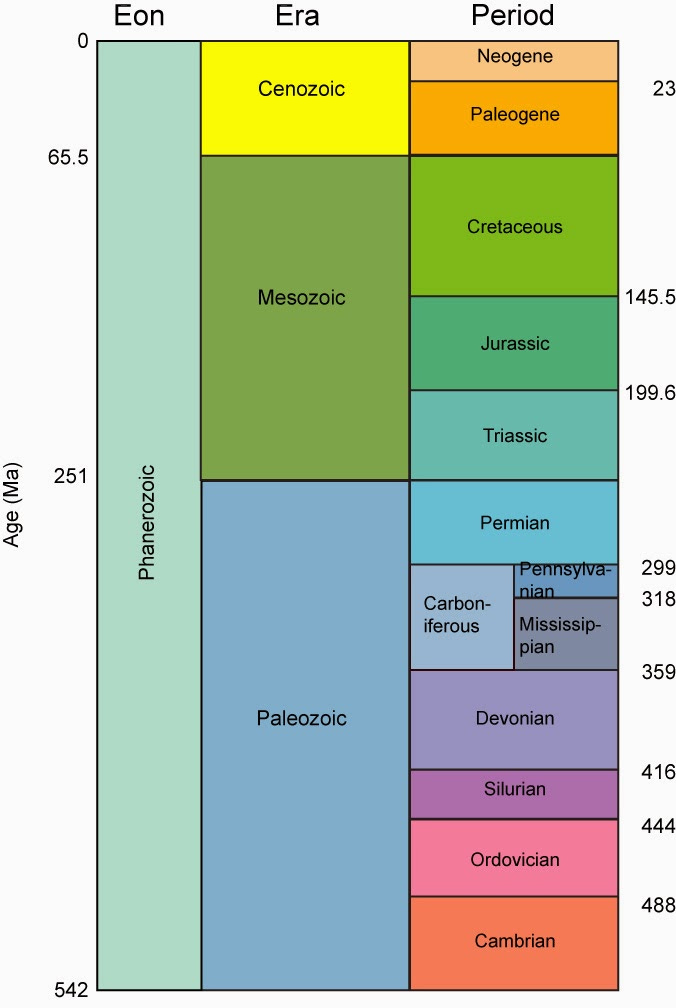

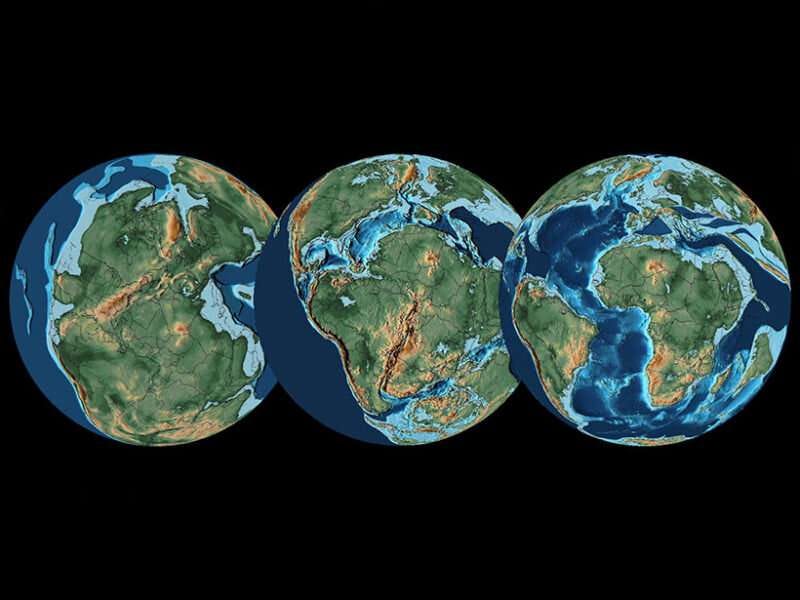
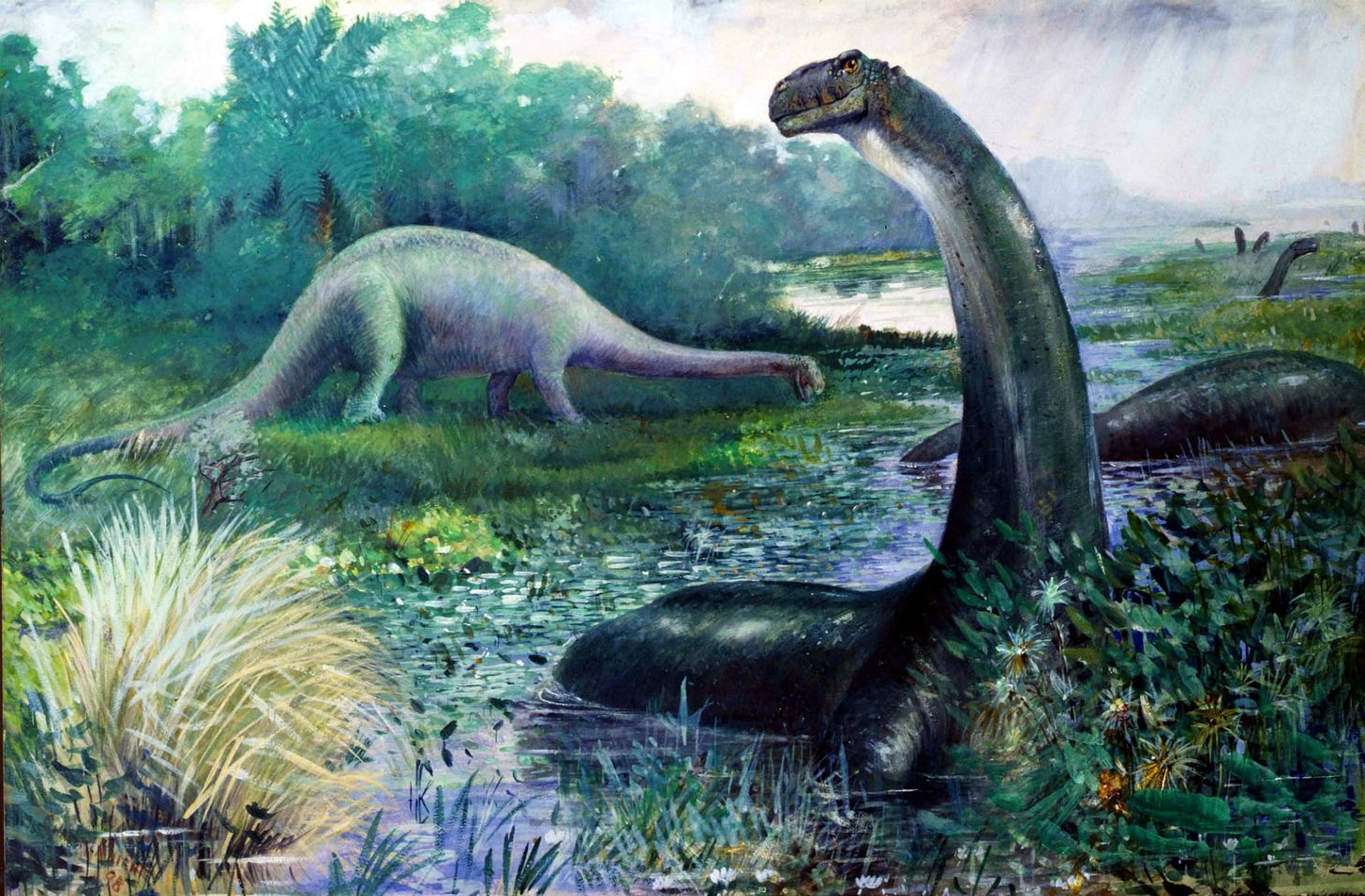

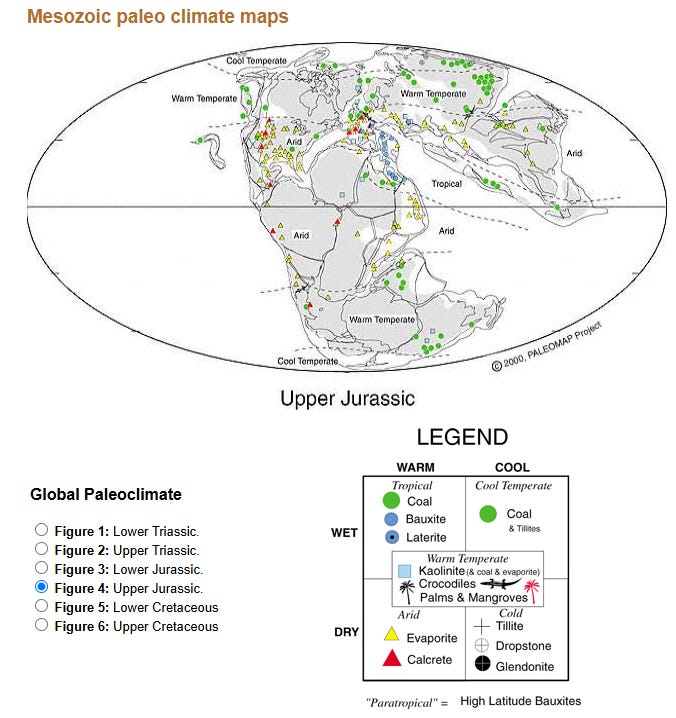

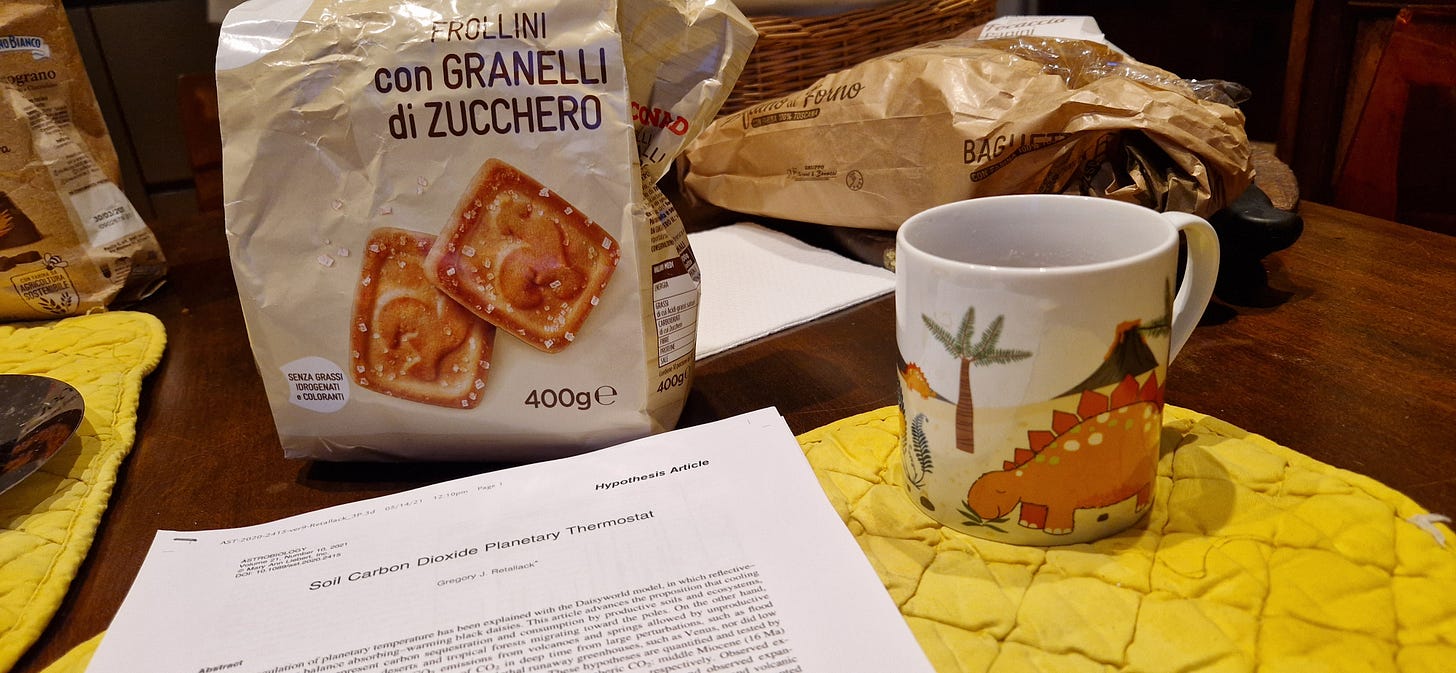
All interesting speculations of Gaia's past lives, Ugo. I hope it is good, organic coffee.
I wondered if you would mention C4 carbon-fixing plants.
"The evolution of “C4” plants has changed the game."
Very Insightful!!!